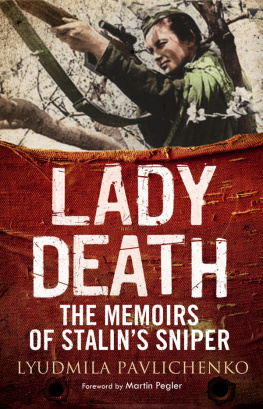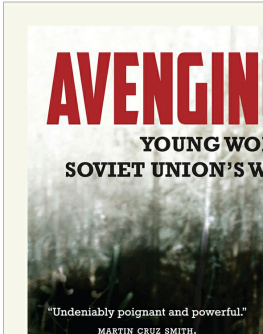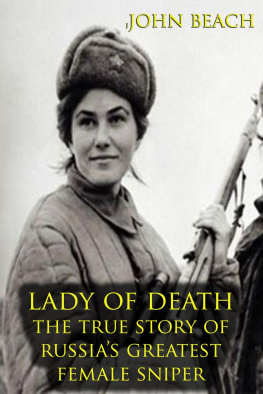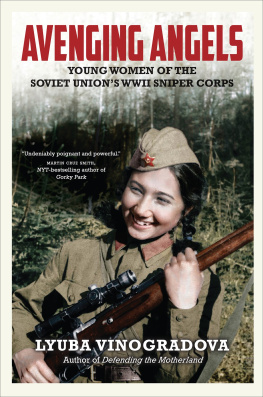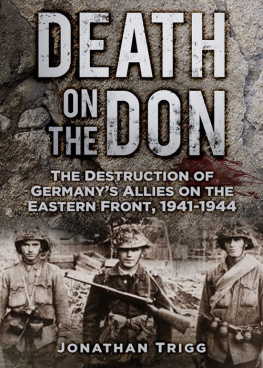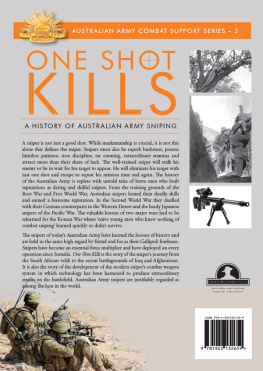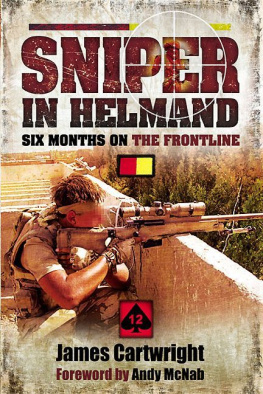
Lady Death
Lyudmila Pavlichenkos skills with a rifle are matched in this magnificent memoir by her abilities as a writer. In clear, lively prose she describes how her pre-war enthusiasm for target shooting enabled her to become one of the Red Armys most feared front-line snipers on the Eastern Front. Arguably the finest account of sniping during World War II.
Adrian Gilbert
author of Challenge of Battle
Within a year after the launching of Operation Barbarossa, Hitlers invasion of Russia in June 1941, a twenty-four-year-old Kiev female history student enlisted in the Russian Army and became one of the deadliest military snipers of all times, in any army, in any war. Lady Death is Lyudmila Pavlichenkos taut and gritty memoirs of the most dangerous woman in the world, who accumulated more than 500 confirmed or probable kills. Translated from the original Russian and based on her post-war notes and wartime diary, it is undoubtedly literatures most remarkable account of sniper action.
Charles W. Sasser
former US Army special forces soldier
and author of One Shot-One Kill
Lyudmila Pavlichenko, the highest scoring female sniper to come out of the Red Army, provides an intimate portrayal of the struggles and obstacles Red Army combatants faced and overcame as the war on the Eastern Front unfolded. She not only proved herself on the field of battle, but also was one of the few Soviet citizens allowed to campaign for the war effort abroad and as such offers an additional, unique view of the west through a Soviet veterans eyes.
Yan Mann
Military Historian
Available:
SNIPERS AT WAR
An Equipment and Operations History
John Walter
EASTERN FRONT SNIPER
The Life of Matthus Hetzenauer
Roland Kaltenegger
RED ARMY SNIPER
A Memoir of the Eastern Front in World War II
Yevgeni Nikolaev
Forthcoming:
THE SNIPER ENCYCLOPAEDIA
An Illustrated History of World Sniping
John Walter
Lady Death
The Memoirs of Stalins Sniper
Lyudmila Pavlichenko
Foreword by Martin Pegler
Translated by David Foreman
Edited by Alla Igorevna Begunova
Lady Death: The Memoirs of Stalins Sniper
Greenhill Books, c/o Pen & Sword Books Ltd,
47 Church Street, Barnsley, S. Yorkshire, S70 2AS
For more information on our books, please visit
or write to us at the above address.
Russian text copyright Alla Igorevna Begunova, 2015
David Foreman English-language translation Greenhill Books, 2018
Foreword copyright Martin Pegler, 2018
Publishing History
Lady Death: The Memoirs of Stalins Sniper was first published by
Veche Publishers (Moscow) in 2015 as I Sniper: In Battles for Sevastopol and Odessa
All rights reserved. No part of this publication may be reproduced, stored in or introduced into a retrieval system, or transmitted, in any form, or by any means (electronic, mechanical, photocopying, recording or otherwise) without the prior written permission of the publisher. Any person who does any unauthorized act in relation to this publication may be liable to criminal prosecution and civil claims for damages.
CIP data records for this title are available from the British Library
ISBN 978-1-78438-270-4
eISBN 978-1-78438-271-1
Mobi ISBN 978-1-78438-272-8
Illustrations
Sniper Lyudmilla Pavlichenko of the 54th Stepan Razin Regiment
Senior Sergeant Lyudmila Pavlichenko, Sevastopol, March 1942, carrying a Mosin Nagant M.1891/30 with PEM scope
A Mosin M.1891/30 sniper rifle with PU sight
An SVT-40 with PU sight
The snipers diploma awarded to Lyudmila Pavlichenko, 6 April 1942
Bombed buildings and transport services, Sevastopol, 1942
A bombed building in Sevastopol, 1942
Junior Lieutenant Alexei Kitsenko and Senior Sergeant Lyudmila Pavlichenko, Sevastopol, January 1942
The leaflet Shoot the Enemy and Dont Miss!
Lyudmilla Pavlichenko with an SVT-40 over her shoulder, Sevastopol, probably taken in January/February 1942
1113 In January/February 1942 several press photographs were taken of Pavlichenko with her presentation SVT-40
Pavlichenko in the summer of 1942, probably after 16 July when she was promoted to junior lieutenant and received the Order of Lenin
A press photograph, perhaps also from summer 1942
Soldiers and officers of the coastal army with their decorations and medals
Junior Lieutenant and sniper platoon commander Lyudmila Pavlichenko with her troops (32nd Guards Parachute Division), Moscow military district, August 1942
Pavlichenko in front of a portrait of the Supreme Commander, shortly before her visit to the USA
Lyudmila Pavlichenko, probably at the time of her trip to the USA
Another photograph from the same time, with her decorations visible: Badge for Distinguished Sniper, Guards Badge, the Order of Lenin and the medal for Battle Merit
The Soviet delegation to the 1942 international student assembly: Nikolai Krasavchenko, Vladimir Pchelintsev and Lyudmila Pavlichenko
The Young Communist League delegation outside the Soviet embassy in Washington, DC
Pavlichenko with Eleanor Roosevelt and Justice Robert Jackson
Lyudmila Pavlichenko, Donald Brown, owner of a tea factory and activist in the charitable public organization Russian War Relief, and Vladimir Pchelintsev in Baltimore, USA, October 1942
Lyudmila Pavlichenko meeting Joseph Davis, former US ambassador to Moscow
A photograph given by Eleanor Roosevelt to Lyudmila Pavlichenko
A rare informal photograph of Pavlichenko, from the time of her visit to the USA
Photograph taken during Pavlichenkos address to the international student assembly in September 1942, in the Grand Hall of the American University in Washington, DC
The Lord Mayor of Birmingham, Walter Lewis, with Pavlichenko and Pchelintsev
Pavlichenko and an officer of the British Royal Air Force view Allied aircraft at RAF Heathfield, in Ayre, November 1942
Pavlichenko with textile workers in Manchester, November 1942
Pavlichenko with Agnia Maiskaya, the wife of the Soviet ambassador to Britain at the reception to celebrate the twenty-fifth anniversary of the October Revolution
Major Lyudmila Pavlichenko of the Soviet coast guard, 1964
Veterans of the second defence of Sevastopol at a jubilee celebration in honour of the citys liberation (May 1964)
Foreword by Martin Pegler
Within the field of sniping literature this memoir is completely unique, for it is the first ever written by a female front-line sniper. Lyudmila Mykhailovna Pavlichenko was not just any sniper, however, for she was to become the highest-scoring female sniper, with 309 official kills. Official kills, it should be noted, were those observed by a second party. In common with most snipers, many of Pavlichenkos kills were made during attacks where stopping to take notes of how many enemy soldiers had been dispatched was neither wise nor practical. Her exact total therefore remains unknown, but around 500 would not be improbable.
On another level, this remarkable memoir also sets the record straight about much of the ill-founded criticism and inaccurate writing that has been subsequently aimed at her, particularly suggestions that she was not a sniper at all, but the product of the Red Army propaganda machine. Once geared up to laud the exploits of an individual, the Soviets were indeed formidable creators of myths, but Pavlichenko as well as fellow sniper Vasily Grigoryevich Zaitsev were the genuine article. Indeed, it is ironic that had their unwanted fame not caused them to be plucked from their front-line duties when they were, there is little doubt that both would merely have become names on a war memorial. The lifespan of a Soviet sniper was normally short; at Stalingrad, neophyte snipers had an expected combat life of two weeks. The longer you survived, the better you became and the stronger the chances were that you would live up to a point. But in warfare, there is a law of diminishing returns where front-line combat is concerned, and eventually battle fatigue, sheer physical exhaustion and the willpower to continue will take their toll and mistakes happen. The life of a sniper was not unlike that of a pilot, for it could be ended by one mistake and there was seldom a second chance.
Next page
